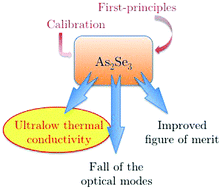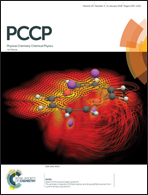Ultralow and anisotropic thermal conductivity in semiconductor As2Se3†
Abstract
An ultralow lattice thermal conductivity of 0.14 W m−1 K−1 along the ![[b with combining right harpoon above (vector)]](https://www.rsc.org/images/entities/i_char_0062_20d1.gif) axis of As2Se3 single crystals was obtained at 300 K using first-principles calculations involving density functional theory and the resolution of the Boltzmann transport equation. This ultralow lattice thermal conductivity arises from the combination of two mechanisms: (1) a cascade-like fall of the low-lying optical modes, which results in avoided crossings of these with the acoustic modes, low sound velocities and increased scattering rates of the acoustic phonons; and (2) the repulsion between the lone-pair electrons of the As cations and the valence p orbitals of the Se anions, which leads to an increase in the anharmonicity of the bonds. The physical origins of these mechanisms lie in the nature of the chemical bonding in the material and its strong anisotropy. These results, whose validity has been addressed by comparison with SnSe, for which excellent agreement between the theoretical predictions and the experiments is achieved, point out that As2Se3 could exhibit improved thermoelectric properties.
axis of As2Se3 single crystals was obtained at 300 K using first-principles calculations involving density functional theory and the resolution of the Boltzmann transport equation. This ultralow lattice thermal conductivity arises from the combination of two mechanisms: (1) a cascade-like fall of the low-lying optical modes, which results in avoided crossings of these with the acoustic modes, low sound velocities and increased scattering rates of the acoustic phonons; and (2) the repulsion between the lone-pair electrons of the As cations and the valence p orbitals of the Se anions, which leads to an increase in the anharmonicity of the bonds. The physical origins of these mechanisms lie in the nature of the chemical bonding in the material and its strong anisotropy. These results, whose validity has been addressed by comparison with SnSe, for which excellent agreement between the theoretical predictions and the experiments is achieved, point out that As2Se3 could exhibit improved thermoelectric properties.



 Please wait while we load your content...
Please wait while we load your content...